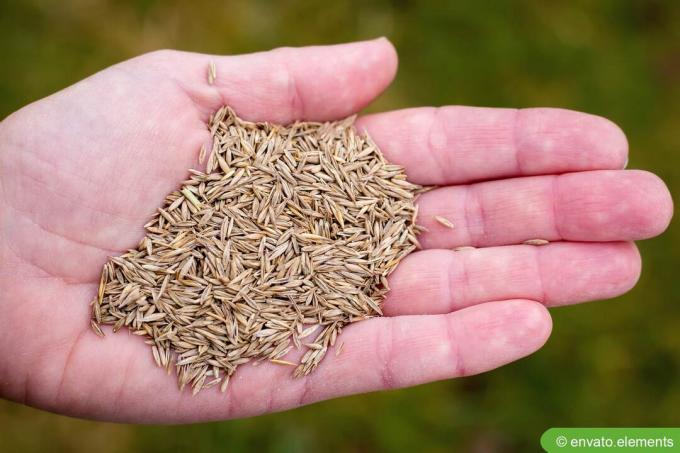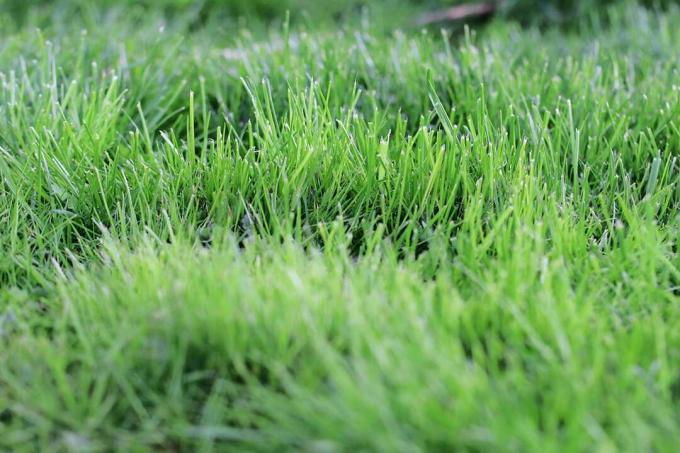

Table of contents
- Characteristics
- When should a turf be laid?
- Preparation of the ground
- 1. Remove old grass
- 2. Check soil condition
- 3. improve soil
- 4. loosen soil
- 5. fine straightening
- 6. rolls
- 7. starting fertilizer
- 8. Rake up again
- Lay turf
- Care instructions for turf
- 1. Water
- 2. mowing
- 3. Fertilize
- Turf prices
What was just a construction site now appears in lush green. Above all, the rapid greening and creation of a finished lawn without a long wait is what prompts gardeners and homeowners to opt for a rolled turf. However, anyone who thinks that a lawn grows everywhere is wrong. In unfavorable location and soil conditions, the lawn dries out quickly or is pushed out by unloved moss. That's why a good surface is important - also for turf.
Characteristics
- other name: turf, turf
- finished piece of lawn including roots
- is sown in large areas and harvested after about a year
- very high quality seed
- dense, closed turf
- almost weed-free, dense and lush green
- Variants: sports turf, play turf, premium turf
When should a turf be laid?
In principle, a rolled turf can always be laid if the ground is frost-free. In principle, it can also be laid out in midsummer, but the lawn then has to be watered very often to grow. The best time to carry out the turf project is in the spring. Then the lawn has enough time to grow and does not have to be constantly watered. A freshly laid turf is fully resilient after just a few weeks.
Preparation of the ground
What many hobby gardeners underestimate: a rolled turf can only grow optimally and remain dense and lush green with good soil preparation. Therefore, the soil conditions should be examined carefully in advance. In very few gardens is the subsoil really optimal.
1. Remove old grass
Would you like to replace your old lawn with a new turf? Perhaps this is riddled with weeds and moss or has only grown sparsely? Without changes in the soil environment, the new rolled turf will quickly look similar. In order for the turf to be laid, the old turf must first be removed. The best way to do this is to use a sod peeler, which simply cuts off the grass along with its roots at a certain depth.
2. Check soil condition
Before you start tilling the soil, you should remove all roots, stones and plant debris.
- Check soil conditions (heavy, sandy or humic)
- Is the soil well permeable to water or does it tend to become waterlogged?
- Is the subsoil clayey and heavy or is it humic and finely crumbly?
- Is the soil mostly sand or clay?
- What is the pH of the soil?
Lawns prefer humus-rich soil that is able to store water well but does not produce waterlogging. If you have a less than optimal soil in the garden, that's not a problem. You can easily and specifically improve your garden soil.
Tip:
If you are not sure what properties your garden soil has, you can have a soil analysis carried out. An analysis set is available from specialist retailers for around 20 euros.
3. improve soil
If the ground conditions are not ideal, now is the unique opportunity to change something. This is usually quite simple:
- Mix heavy clay soil with compost (humus) and sand
- work up sandy soils with humus
- very acidic pH values: lightly lime the soil

You should then level the area by eye so that there are no rough bumps in the ground.
4. loosen soil
For small lawns, the soil can be dug up with a digging fork or a spade. If larger areas are planned, the gardener will find it easier to use a tiller or rotary harrow. These can be borrowed for relatively little money from garden equipment rentals. At least 10 centimeters of soil depth must be loosened, more is even better. Additives such as sand, humus or lime can be worked into the soil at the same time.
5. fine straightening
Now level the loosened soil with a fine rake. Take a lot of care in this step, since later unevenness can only be leveled out with a great deal of effort. Remove any coarse debris that collects on the surface.
6. rolls
The top layer of soil is now very loose. If the turf were applied at this point in time, the rainwater would wash out and settle over time. To prevent this, the raked area is secured with a garden roller. If there are still bumps, they are leveled again with the rake and rolled again.
Tip:
The distance between the top edge of the path or terrace stone and the leveled ground should be about 2 centimeters. This is the only way the rolled turf can later be laid flush.
7. starting fertilizer
Anyone who has not carried out a soil analysis and can use it to fertilize in a targeted manner should definitely treat their turf with a special starter fertilizer so that the lawn can grow well.
8. Rake up again
Once the surface has been fertilized and rolled, it is carefully raked up again about 1 centimeter deep. In this way, the fertilizer is worked into the soil, the direct subsoil is loosened and minor unevenness (such as footprints) is evened out.
Tip:
If you often have problems with moles in your garden, it is advisable to install a special anti-mole fabric.
Lay turf
Usually, rolled turf is delivered in long, narrow strips that are folded into a roll during transport. After arriving in the garden, the rolled turf must be laid immediately and under no circumstances should it lie around rolled up for a few hours.
- start on the patio or sidewalk side
- lay on a long side (not in the middle)
- preferably on a straight side
- Lay curved edges at the end
- Lay the rolled turf on the raked area without leaving any gaps
- roll with a garden roller after laying is complete
- so he gets good contact with the ground
After laying, you must now water the lawn very carefully and evenly - even when the sun is shining! Otherwise the lawn will dry out and not grow. As a rough measure of the amount of water you can calculate with about 20-25 liters per square meter. Important: The lawn must not be walked on afterwards, as the subsoil is now very soft.
Tip:
When it is very hot, you must not wait until the entire lawn has been laid before watering, but rather water sections that have already been laid.
Care instructions for turf
1. Water
In the first two weeks, the lawn roots do not have intensive contact with the ground. Therefore, in dry weather, the sod must always be kept moist with the garden hose (at least once a day). If possible, do not step on the lawn during this time!
2. mowing
The first cut of a new turf is something very special and needs to be done with a little care. This also includes freshly sharpened lawnmower blades.
- Time: after about 8-14 days
- the lawn must not be higher than about 7-10 centimeters
- cut no deeper than 5 centimeters on the first cut
- further cuts: between March and October once a week to about 4 cm
- with shorter cuts, the lawn burns quickly
3. Fertilize
After about six weeks, the nutrients from the starter fertilizer are used up. During the growing season, lawn fertilizer should be applied about 3-4 times. Quantity: 50 g per square meter. Alternatively, use long-term fertilizer.
Turf prices
Depending on the quality, a square meter of rolled turf including delivery is available from around 3 euros. With small purchase quantities, the price increases to around 5-6 euros. The rolled turf is usually delivered in strips, each 40 cm wide and 2.5 m long.
 garden editorial
garden editorial I write about everything that interests me in my garden.
Learn more about creating a lawn

Just sprinkle lawn seed: is that enough?
At some point, every lawn will have one or two bare spots, which you can best close with quick overseeding. Read why simply sprinkling the lawn seed is often not such a good idea.

When can you mow a freshly seeded lawn?
Freshly seeded lawns require some care when caring for them. This also includes not stepping on it or mowing it at first. But timely and regular trimming of the grass is crucial for dense growth.

Straighten the garden and level the lawn: 11 tips
In order to be able to use your garden as effectively as possible, a flat surface is much better. Nevertheless, many floors and lawns are uneven, which makes gardening noticeably more difficult. With the right tips, you can straighten your lawn and soil.

Herb meadow: 6 tips for creating
A herb meadow is not only pretty to look at, but also very easy to care for. In this article, we will tell you how you can create a herb lawn!

Creating a flower lawn | 8 tips on seeds and care
If you want to create a flower lawn, you need patience and diligence. The effort is already worth it from the second year. Then the mixture of wildflowers and grasses blooms in colorful tones. Maintenance is reduced to a minimum in the years that follow.

Laying turf | Information on preparation, costs, timing and maintenance
If you don't want to wait long for your lawn to grow, rolled turf is a sensible alternative. But even with the pre-cultivated lawn rolls that can be laid like a carpet, there are a few things to consider. You can find helpful information about preparation and installation here.



